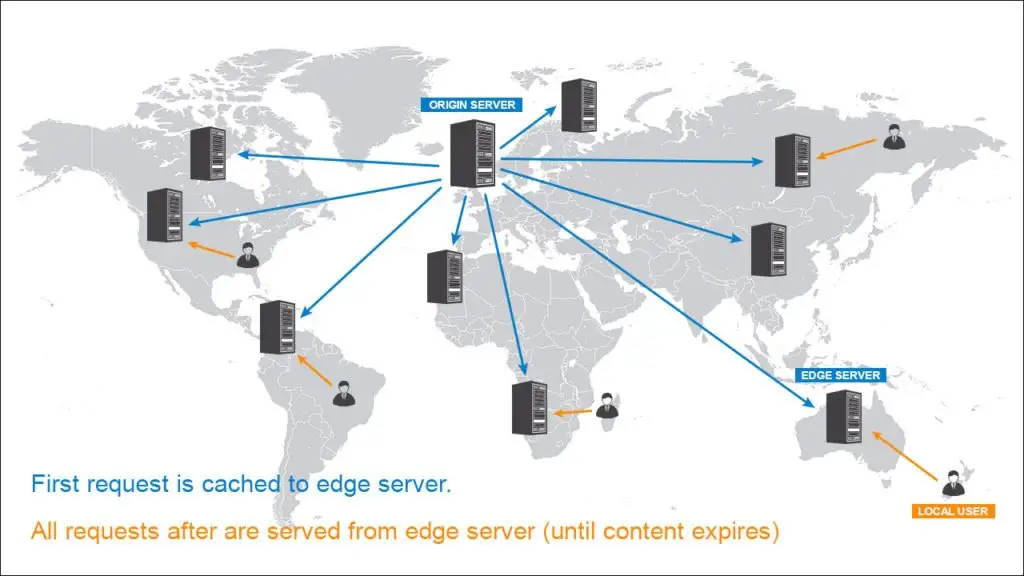Content Delivery Network (CDN) Optimization Techniques for High-Definition Content

1. Edge Caching:

- Position cache servers at the “edge” of the network, closer to end-users.
- Stores frequently accessed content, such as HD video segments, in these caches.
- Reduces latency and improves load times.
2. Adaptive Bitrate Streaming (ABR):

- Delivers video content at multiple bitrates to cater to different network conditions.
- Allows users to switch seamlessly between bitrates to maintain optimal playback quality.
3. Content Prefetching and Preloading:
- Anticipates user requests and preloads HD content into caches before it is actually requested.
- Eliminates the initial delay in content delivery.
4. Optimized Chunk Size:
- Divides HD video into smaller chunks for faster delivery and reduced buffering.
- Optimizes chunk sizes for different network conditions and content types.
5. Load Balancing and Failover:
- Distributes incoming traffic across multiple CDN servers to avoid overloading.
- Configures failover mechanisms to ensure continuity of service in case of server failures.
6. Video Compression and Transcoding:
- Compress HD video using efficient codecs to reduce file size without compromising quality.
- Transcode video into multiple formats to support different devices and platforms.
7. Caching Headers Optimization:
- Configures HTTP caching headers (e.g., Expires, Cache-Control) to control how long content is cached by browsers and CDN servers.
- Optimizes cache durations to improve content availability.
8. Performance Monitoring and Analytics:
- Monitors CDN performance metrics such as latency, throughput, and error rates.
- Analyzes data to identify areas for improvement and optimize delivery strategies.
9. Geolocation and Geo-Restrictions:
- Determines the geographical location of end-users and delivers content from the nearest CDN nodes.
- Enforces geo-restrictions to comply with content distribution rights.
10. Content Mirroring:
- Replicates HD content to multiple CDN nodes, ensuring fast delivery even during peak traffic periods.
- Improves content availability and reduces the risk of outages.# CDN Optimization Techniques for High-Definition Content
Executive Summary
Content Delivery Networks (CDNs) play a vital role in optimizing the delivery of high-definition (HD) content to enhance user experience and reduce website latency. This article provides a comprehensive guide to CDN optimization techniques for HD content delivery, covering essential aspects such as CDN selection, content caching, network optimization, and performance monitoring. Implementing these techniques effectively can significantly improve the quality of video streaming, downloads, and overall website performance.
Introduction
The demand for HD content is rapidly growing across various platforms, including streaming services, social media, and e-commerce platforms. To meet this demand, businesses must ensure seamless delivery of HD content without compromising on quality or user experience. CDNs, by distributing content across geographically dispersed servers, enable efficient and reliable HD content delivery. By optimizing CDN performance, organizations can improve video streaming quality, reduce buffering, and enhance overall website responsiveness.
FAQs
-
What is a CDN and how does it work?
A CDN is a network of servers distributed globally to deliver content to users from the nearest location, reducing latency and improving content delivery speed. -
Why is CDN optimization important for HD content?
HD content requires high bandwidth and rapid delivery to ensure a seamless user experience. CDN optimization techniques help in delivering HD content efficiently and reducing buffering by optimizing network performance and caching mechanisms. -
How can I choose the right CDN for my needs?
Consider factors such as the CDN’s global presence, network reliability, content caching capabilities, and customer support when selecting a CDN. It’s recommended to conduct thorough research and evaluate different CDN providers before making a decision.
Top 5 Subtopics for CDN Optimization
1. CDN Selection
- Evaluate Provider Capabilities: Assess the CDN’s network size, number of servers, and geographic distribution to ensure adequate coverage for your target audience.
- Consider Content Types: Choose a CDN that supports the specific types of HD content you intend to deliver, including video, images, and documents.
- Assess Pricing Structure: Compare the pricing models of different CDNs and choose a provider that offers flexible and cost-effective options.
- Look for Integration Options: Ensure that the CDN integrates seamlessly with your existing website and content management systems to streamline content delivery.
- Consider Security Features: Evaluate the CDN’s security measures, data encryption protocols, and DDoS protection capabilities to ensure data safety and website protection.
2. Content Caching
- Leverage Browser Caching: Implement HTTP headers such as Expires, Cache-Control, and ETag to instruct browsers to cache static content, reducing server load and improving content retrieval speed.
- Utilize CDN Caching: Configure CDN caching policies to store frequently requested HD content on edge servers, enhancing content delivery efficiency and reducing latency.
- Purge Stale Content: Regularly remove outdated or expired HD content from the CDN cache to ensure users always access the latest version.
- Monitor Cache Performance: Track cache hit rates and cache storage utilization to identify areas for optimization and ensure efficient content delivery.
3. Network Optimization
- Minimize Latency: Optimize network routes and leverage dedicated fiber connections to reduce latency and improve content delivery speed.
- Utilize Load Balancing: Distribute traffic across multiple CDN servers to avoid overloading and ensure stable performance during peak traffic periods.
- Configure Content Compression: Implement data compression techniques such as GZIP and Brotli to reduce the size of HD content, resulting in faster downloads and lower bandwidth consumption.
- Enable HTTP/2 Support: Upgrade to HTTP/2 protocol to enhance website performance and reduce page load times for HD content.
4. Performance Monitoring
- Track Key Metrics: Monitor metrics such as latency, download speed, and video buffering time to assess CDN performance and identify potential bottlenecks.
- Conduct Regular Testing: Perform periodic testing to evaluate content delivery efficiency, identify areas for improvement, and ensure a consistent user experience.
- Utilize Analytics Tools: Integrate CDN analytics tools with your website to track user behavior, content consumption patterns, and identify potential issues impacting HD content delivery.
- Monitor CDN Logs: Analyze CDN logs to troubleshoot errors, identify resource bottlenecks, and optimize CDN configuration for enhanced performance.
5. Advanced Techniques
- Implement HTTP Adaptive Bitrate (ABR): Adapt the bitrate of HD content based on network conditions and device capabilities to ensure seamless video playback and reduce buffering.
- Use Geo-Blocking and Geo-DNS: Restrict access to HD content by geographic location to comply with content rights and licensing restrictions.
- Leverage Multi-CDN Solutions: Utilize multiple CDN providers to enhance network resilience, optimize content delivery, and minimize downtime.
- Consider Cloud-Based CDN Services: Explore cloud-based CDN solutions that offer scalable, pay-as-you-go pricing models, eliminating the need for infrastructure investment.
Conclusion
Optimizing CDNs for HD content delivery is crucial for businesses aiming to provide high-quality user experiences and maintain website performance. By implementing the CDN optimization techniques discussed in this article, organizations can effectively reduce latency, enhance content caching efficiency, optimize network performance, and monitor CDN performance to deliver HD content seamlessly. These techniques help businesses meet the growing demand for HD content, improve customer satisfaction, and gain a competitive edge in the digital market.
Keyword Tags
- CDN optimization
- HD content delivery
- Content caching
- Network optimization
- Performance monitoring
